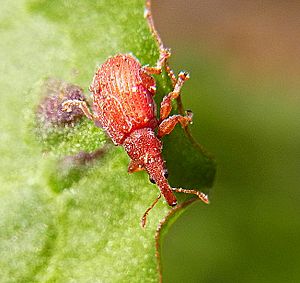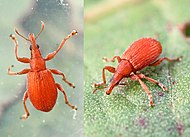Apion frumentarium
| Apion frumentarium | ||||||||||||
|---|---|---|---|---|---|---|---|---|---|---|---|---|

Apion frumentarium |
||||||||||||
| Systematics | ||||||||||||
|
||||||||||||
| Scientific name | ||||||||||||
| Apion frumentarium | ||||||||||||
| ( Linnaeus , 1758) |
Apion frumentarium ( synonym Apion miniatum ) is a beetle from the family of Brentidae , subfamily Apioninae , whichbelongsto the relatives of the weevils . The genus Apion traditionally included a large number of differently colored species , today the genus only includes the species of the former subgenus Apion s. st. They all have a solid red body. The genus Apion is represented in Europe with nine species ,some of which are difficult to distinguish.
Notes on the name
The generic name Apion from ancient Greek ἄπιον 'ápion' 'pear' refers to the body shape of the animal, but this shape is also found in related genera. The species name frumentarium means 'living on grain'. The first person to describe it , Linnaeus, was of the opinion that the larva of the species lived on wheat grains. For this reason, the species was sometimes called the German name Roter Kornwurm, which is probably due to a confusion between the larvae of the grain beetle and the larvae of Apion frumentarium . The black larvae of the grain beetle are red shortly after molting. However, the Apion frumentarium larva develops in different species of dock. The small beetles bear the German generic name Spitzmausrüssler or Spitzmäuschen because of their head pulled out into a trunk.
When evaluating the literature, it should be noted that Apion frumentarium (Linnaeus) is not identical to Apion frumentarium (Paykull). Apion frumentarium (Linnaeus) is synonymous with Apion miniatum (Germar) and in the first edition of the standard work Freude-Harde-Lohse the species Apion haematodes (Kirby) is described under Apion frumentarium (Paykull) . The common name sorrel shrew weevil is not correct as a name for Apion frumentarium (Linnaeus), but for Apion haematodes (Kirby). It mainly uses large and small sorrel as host plant, while Apion frumentarium (Linnaeus) prefers other types of dock .

|

|
| Fig. 1: Top view and front | Fig. 2: underside |

|
 Middle leg colored yellow: trochanter; blue: thigh; green: hip |
| Fig. 3: Side view of the head | Fig. 4: Detail from the bottom |
Characteristics of the beetle
The 3.3 to 4.5 millimeter long beetle is a single color, light red and has fine and thin hair on the top. The other Central European species of the genus are on average smaller.
The head is pulled forward to form a trunk that is consistently thick when viewed from above. It's about as long as the rest of the head. In a side view it is bent downwards (Fig. 3). The small mouthparts are at the tip of the trunk. The upper lip is missing. The eleven-part antennae are turned in at the side about the middle of the trunk. The short feeler pit runs backwards and downwards. The eleven-part antennae are not kneeled and end in a three-part club. The last link is curled, so a four-link club is simulated (Fig. 3). The bulging eyes are on the side of the head. The head is roughly punctured , the puncture extends over the entire temples, these are not shiny and smooth at the back and not very finely dashed crosswise (Fig. 3). The head widens conically towards the rear, it is significantly longer from the front edge of the eye to the pronotum than it is wide above the eyes. Viewed from the side, the temples are longer in relation to the diameter of the eyes than in the other species of the genus.
The pronotum is slightly wider at the front edge than the head and wider at the back. The sides are moderately curved and broadest in front of the middle, constricted in front. The head and pronotum are roughly equally dotted.
The wing covers are arched and widen roundish to the rear. Already at the base they are together significantly wider than the pronotum, the shoulders are clearly developed. The wing covers are clearly streaked.
All legs end in four-limbed tarsi . The trochanters (yellow in Fig. 4) are large and completely separate the thighs (blue in Fig. 4) from the hips (green in Fig. 4).
egg
The eggs are transparent, 0.6 millimeters long and 0.35 millimeters wide.
larva
The width of the head capsule averages 0.26 millimeters in the first larval stage, 0.43 millimeters in the second, and 0.60 millimeters in the third and last.
biology
The larvae live in Central Europe in the root neck and in the stems of various large dock species , especially the river dock . In addition, the larva develops in the field weeds Emex spinosa (pitcher, Mediterranean region) and Emex australis (South Africa, introduced to Australia) and rheumatoid species. The species thus shows a wider range of host plants than related species, but the known host plants are almost exclusively restricted to the knotweed family . The host plants possibly characterize different breeds of the species, at least behavioral differences between the European Rumex -associated and the Emex -associated animals from Israel were found. In Central Europe, the beetles can be found from April to October.
The following observations were made in the laboratory for specimens from Emex spinosa from Israel . The adults drill small holes in the surface of the leaves that are about 1.6 mm² in area and shallow (bullet holes) to eat. Almost exclusively knotweed were accepted in feeding experiments , but more plant species were used as a source of food than for oviposition. The development up to the Imago was only completed when the eggs were laid in the genera Rumex and Emex . The damage to the plant by eating is negligible.
After reaching sexual maturity, the males begin copulation attempts. If a male tries to climb another male, the person who has climbed taps the ground with his abdomen, thereby breaking off the climber's attempt. However, this behavior was not observed in the animals from Israel in the study. Here the males seemed to recognize the sex of their conspecifics and only climbed females.
The eggs were laid individually in the petioles or on stems. To do this, the females drill holes in the plant similar to the feeding holes and lay an egg in them. However, the hole is too small to completely accommodate the egg, the protruding part is covered with a black abdomen excrement. The oviposition extended from winter to the onset of the summer break. The larvae hatched from the egg after five to seven days. When they had hatched in the petiole, they bored towards the stem axis. The larvae from eggs laid in the stem ate their way up the stem. Later larval stages were in the upper root area and the entire stem, predominantly in the upper area. There are three larval stages. Pupation also takes place in the shoot axis and the upper root area. The overall development from egg to imago took three to four months. The newly hatched adults need about a week to color.
The animals hid in the ground for about four months during the summer, after which they became active again. Infested Emex spinosa plants can be recognized by the shortened internodial distance. If the infestation was too dense, the plants died.
The species shows a one-year development cycle . The number of eggs laid depends heavily on the host plant available. The order in which the plant species preferred to lay eggs was not found to be in the same order as they did for feeding. The river dock was not included in the study; during the main activity of Emex spinosa , an average of almost forty eggs were laid per female in fourteen days, but the number of eggs was even higher in various Rumex species.
In the blunt-leaved dock ( Rumex obtusifolius ), the females lay the eggs on the midrib of the lower leaves. The larvae only drill in the lower parts of the stem and in the roots. On the other hand, the related species Perapion violaceum (Kirby) can be found in the upper areas of the stem .
distribution
The species is distributed across large parts of Europe from Central and Western Asia. The beetle was introduced to Australia for biological control of the field weed Emex australis (unsuccessful).
literature
- Heinz joy , Karl Wilhelm Harde , Gustav Adolf Lohse (ed.): The beetles of Central Europe . tape 10 : Bruchidae – Curculionidae 1 . Goecke & Evers , Krefeld 1981, ISBN 3-87263-029-6 .
- Gustav Adolf Lohse, Wilhelm H.Lucht: The beetles of Central Europe . 3. Supplementary volume with catalog section. Goecke & Evers, Krefeld 1994, ISBN 3-87263-045-8 .
Individual evidence
- ↑ a b Apion frumentarium in Fauna Europaea. Retrieved August 14, 2012
- ↑ Apion at Fauna Europaea. Retrieved August 14, 2012
- ↑ Sigmund Schenkling: Explanation of the scientific beetle names.
- ^ William Kirby: The Genus Apion on Herbst's Natursystem considered, its Characters laid down, and many of the Species described Transactions of the Linnean Society June 1805 p. 78 as PDF
- ↑ Herrman von Nördlinger: The small enemies of agriculture: Or a treatise on kerfe, other articulated animals, worms, etc., which are harmful or annoying in the field, garden and house. Snails m. Bes. Consider. Your natural enemies and D. Protective means applicable against them . Cotta'scher Verlag, Stuttgart and Augsburg 1857
- ↑ Heinz Freude , Karl Wilhelm Harde , Gustav Adolf Lohse (ed.): Die Käfer Mitteleuropas . tape 10 : Bruchidae – Curculionidae 1 . Goecke & Evers , Krefeld 1981, ISBN 3-87263-029-6 .
- ^ Gustav Adolf Lohse, Wilhelm H.Lucht: Die Käfer Mitteleuropas . 3. Supplementary volume with catalog section. Goecke & Evers, Krefeld 1994, ISBN 3-87263-045-8 .
- ↑ a b c d e f g h i j John K. Scott Paul B. Yeoh: Biology and host specificity of Apion miniatum (Coleoptera: Apionidae) from Israel, a potential biological control agent for Emex australis and Emex spinosa (Polygonaceae) in Australia Biological Control, Vol. 33, -1, April 2005 pp. 20-31
- ^ Gunter Freese (1995): Structural refuges in two stem-boring weevils on Rumex crispus . Ecological Entomology, 20: 351-358. doi : 10.1111 / j.1365-2311.1995.tb00467.x